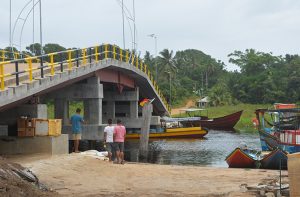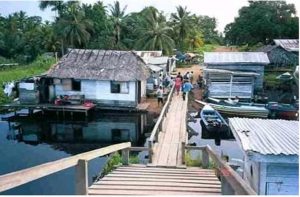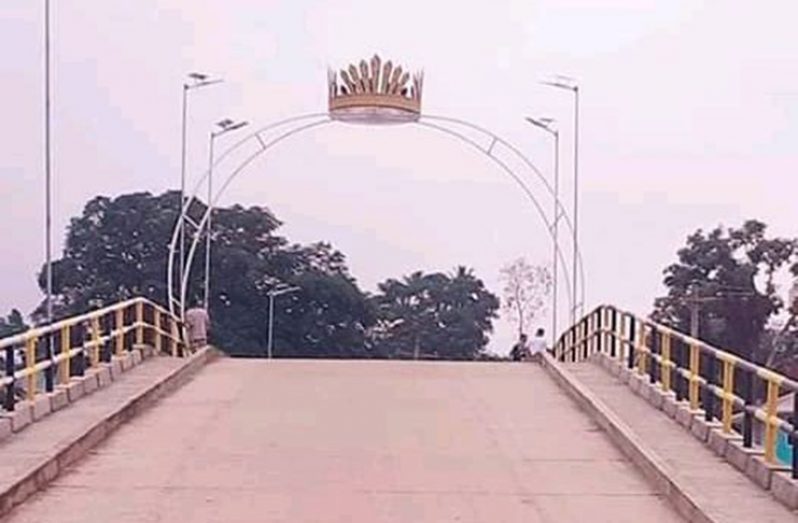–one of the fastest developing Amerindian communities in the country
By Wendella Davidson
THE beautiful community of Moruca, one of three sub-regions in the North West District, the other two being Mabaruma and Matarkai, is one of the areas where the APNU+ AFC Coalition Government has executed several projects, in an effort to make the lives of the Indigenous Peoples who reside there more comfortable.
One such project is a $110M concrete bridge, which will be commissioned on Saturday, January 18, 2020. During 2019, the community of Santa Rosa, the largest Indigenous village in Guyana with a population of over 10,000 residents spread over 11 satellite islands, saw the execution of a number of projects, with the aid of funds from a Presidential Grant.
Among those projects were the construction and furnishing of a multi-purpose centre; the purchase of floodlights; fencing the Santa Rosa Guest House compound, and purchasing woodworking tools and machinery to complement its woodworking facility; converting a bond into a craft centre and purchasing craft items; constructing a marketplace; repairing the village’s vehicle, and setting up a five-acre coconut grove; repairing the village’s cargo boat and setting up a floating/mobile grocery shop; repairing the Seven-Mile Branch Road; purchasing a 15hp Yamaha outboard engine and boat to assist the community with its transportation needs, especially the farmers; purchasing carpentry and boatbuilding tools and sport gear among other items.
Other projects undertaken by the Coalition Government include the setting up of Kwebanna Cassava Processing and the Santa Rosa Ground Coffee facilities; refurbishing the Bemichi Airstrip; and rehabilitating the health post at Parakeese.

Davidson)
Moruca is considered to be one of the fastest developing Amerindian communities, with its 11 titled communities, called ‘satellite villages’, Santa Rosa, Assakata, Kwebanna, Warapoka, Chinese Landing, Waramuri, Santa Cruz, Kariako, Kabucalli, Manawarin and Haimarakabra, with Santa Rosa being the largest and most populated.
The residents of the Moruca sub-region are predominantly Arawak, who subsequently became mixed with other Guyanese ethnicities.
‘ADMIN’ MATTERS
The Village Council, which governs the Moruca community, is located at Kumaka, which is the business hub. It is headed by Toshao Whanita Phillips, while the ‘satellite villages’ are managed by councillors. The government plays an administrative role in the affairs of Moruca, as such it has as its Assistant Regional Executive Officer (AREO) Ms. Rennita Williams, who oversees the affairs of the government in the sub-region.
At Kumaka are a post office; a police station; the Kumaka District Hospital; Government offices; a supermarket and several itinerant vendors who dot the area, offering various items such as clothing and other merchandise for sale.
The Guyana Chronicle, during a recent visit to Moruca, learnt that initially, the administrative block for Moruca was housed at Acquero, but it was subsequently relocated to Kumaka. However, despite being relocated, the police station and the post office have retained their original names, and as such are still known as the Aquero Police Station and Acquero Post Office.
BRIDGING THE COMMUNITIES
On arriving at Kumaka, visitors are greeted by a $110M concrete bridge that links the communities of Kumaka and others to the west and Santa Rosa, Cabucalli, Kummucherie, St Peter’s, Paloma, Acquero, Huradiah, Mathurin Point and Tucupita and others to the east.
It is fitted with handrails, and what looks pretty much like an Amerindian headwear atop an arch and light is by solar lamps, which allows the structure to be quite a masterpiece when illuminated at night.
The two-lane, concreted structure benefits in excess of 10,000 persons, including nurses, teachers and students among others. Several motor vehicles, which are parked daily in the vicinity of the western approach to the bridge, use the bridge to transport passengers to their respective destinations. In the afternoon, it is a common sight to see students, in particular those from the Santa Rosa Secondary School, enjoying the atmosphere along the bridge before making their way home.
The structure replaces two previous ones, the first of which was constructed in the 1980s but was only for use by pedestrians. It was subsequently rehabilitated by the then PPP/C administration to the tune of $43M, and catered for vehicular traffic as well, but was however deemed by residents to be unsuited to their specific needs.
In 2014, additional funds were doled out to carry out revetment works to shore up the eastern end of the bridge, but even those works proved inadequate, and given that it was below water level, residents were forced to construct a makeshift one for when the water level rose.
The new structure which was executed by Mohammed Ramzan Ali Khan Construction Company comprises a concreted deck supported by steel beams and a timber sub-structure and rails, and allows for boats to comfortably pass under as they traverse the waterways to access other far-flung communities that can only be reached by boat.
Residents with whom the Guyana Chronicle spoke recalled having to endure over 23 years of hardship having the then rickety structure that was called a bridge. One female resident told of having to lift her skirt or dress high as she paddled through the water during the rainy season or during high tide to attend church.
OTHER KEY PROJECTS
Construction of a Cassava Flour Processing Factory at Kwebanna Village began in December 2018 at a cost of $10M, and entailed the clearing and preparation of 30 acres of land, and the purchasing of cassava sticks for planting. The project, for which some $26M overall was spent, including equipping the facility, has created employment for several villagers, who either supplied materials or were involved in the actual construction.

constructed (Photo courtesy of the AREO, Rennita
Williams)
The project was initiated by the Ministry of Indigenous Peoples’ Affairs after consultations with the residents, since cassava is one of the main produces in the Kwebanna community, which has a population of approximately 1000 persons and as its main economic activities lumber jacking, hunting, subsistence farming and fishing.
The Santa Rosa Coffee project was initiated after it was found that Moruca has fertile lands with the ability to produce coffee. However, this venture will ensure farmers receive triple dividends for their efforts, since approximately 12,000 seedlings will be planted by fifteen farmers, reaped and processed to supply both the local, regional and later, international markets.
In November 2019, the Moruca sub-district was again in the spotlight when, in observance of the International Year of the Indigenous Languages, and to raise awareness about the endangerment of Indigenous Languages in Guyana, the Ministry of Indigenous Peoples’ Affairs hosted an inaugural Storytelling Festival there.
The event included the singing and reciting of the National Anthem.
THE JOURNEY
Prior to arrival, the journey to Moruca, if travelling from the city, entails travelling by minibus or car to Parika, then boarding either a government-run ferry or a speedboat to Supenaam, then joining a car for a 65km journey along the Essequibo Coast public road to Charity. Once there, you then join one of the popular speedboats to undertake the journey to Moruca by travelling along the beautiful and at times serene Pomeroon River, making use of the opportunity to take in the beauty of the houses that adorn both sides of the river and an approximately 20-mile rough ride on the Atlantic Ocean before entering the Moruca River.
The change of appearance in the colour of the water from black to brown is an indication that the ride on the treacherous Atlantic Ocean was imminent. After a brief stop for records purposes at the Guyana Defence Force Mobile Station, which has a permanent presence not far from the mouth of the Pomeroon River, the approximately 20-minute journey across the vast expanse of brown waters of the Atlantic Ocean is made. The view along that short journey is obscured, as all shutters on the speedboat have to be down to keep out the huge waves.
On entering the Barima-Waini River, one is greeted by once again water black water, and the dexterity of the speedboat operators and knowledge of the waterway is evident from the many meandering turns and twists. Occasionally, too, the operator is forced to come to a halt to avoid the boat’s engine being entangled with floating debris, which the Guyana Chronicle was told, happens when the river falls or ebbs.
Along the way, stops are made at Cart Market, Waramuri and Acquero to either uplift fuel or off-load or pick up passengers.




.png)









